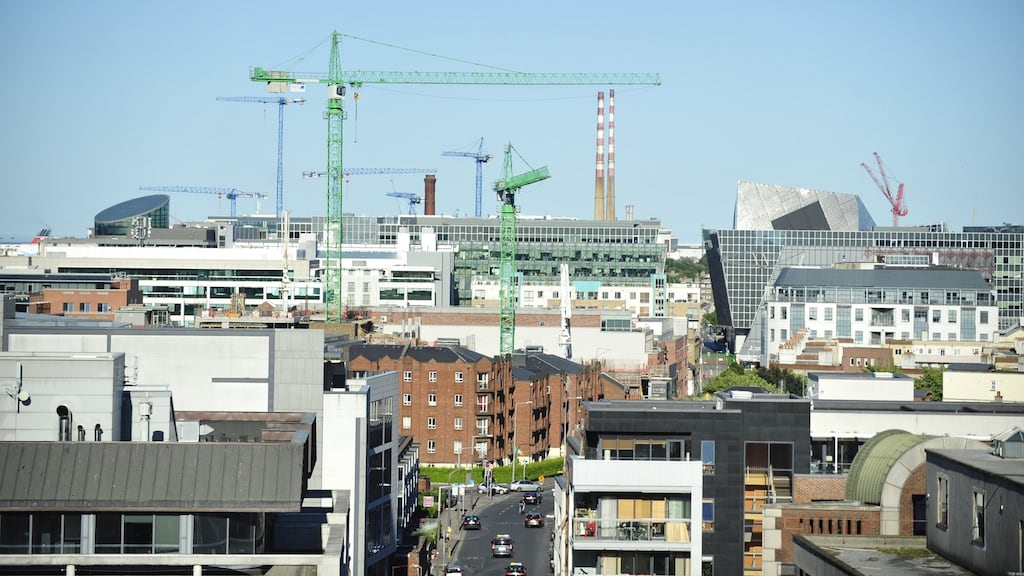A large number of sizeable office schemes are now being built in Dublin. More are on the way, and the skyline is littered with construction cranes. But all is not well in the capital’s office market, particularly in the city centre.
Hannah Dwyer, associate director and head of research at JLL, says a healthy office market should have a vacancy rate of 7 to 9 per cent.
“The vacancy rate in Dublin is currently at 8 per cent across the whole city and suburbs, but there is a real shortage in the city centre, where the vacancy rate is sub-4 per cent,” she says. “Assuming demand remains at the 10-year average of 2 million sq ft per annum, this is expected to continue to decrease.”
Meanwhile, most estate agents say the supply of space coming to the market over the next 18 months to two years will fall well short of the level required to stem upward pressure on rents.
CBRE, for example, says there are 27 office schemes totalling more than 330,000sq m (3.552 million sq ft) of space under construction in Dublin. It expects construction levels in 2017 to be more than double 2016’s level.
However, only 92,308sq m (993,594sq ft) of office space is due for completion in 2016 – and more than half of that is already pre-let, according to Marie Hunt, head of research at CBRE.
20% volume
“To put this into context, total take-up in Dublin in 2015 reached 235,000sq m,” she says. “Meaning that the volume of stock due to come on stream this year – excluding accommodation that has already been pre-let – is less than 20 per cent of the volume of stock let in the capital last year.”
Given these figures, it is not surprising that the significant upward pressure on rents is an issue of growing concern for many firms, facing hefty increases from rent reviews, and others, such as the IDA, tasked with attracting overseas companies to Ireland.
"Prime office rents in Dublin are in the region of €600 per sq m," says Enda Moore, a director at Hooke & MacDonald. "They are likely to peak between €650 and €700 per sq m. Rents will rise until at least 2018, when potential new supply will help the market stabilise. But this is difficult to predict if demand for space fluctuates in the meantime."
However, Aoife Brennan, a director at Lisney, says prime office rents will rise even further, reaching €753.50 per sq m by the end of 2017 and remain at that level in 2018.
“Based on the level of proposed development due to come to the market in the coming years,” she says, “rents will fall to about €700 per sq m in 2019 and could revert to a sustainable level of just below €645 per sq m from 2020.
“Rents will adjust downwards towards 2019/2020 because €753.50 per sq m is not sustainable for a market such as Dublin. We shouldn’t be about the 15th most expensive in the world!”
In landlords’ favour
With rents rising and supply tight, the office rental market has now moved decisively in favour of landlords, with tenants’ incentives, such as rent-free periods and shorter/flexible leases, greatly reduced.
The trend of firms moving to the suburbs also looks set to continue, as tenants who secured low rents in recent years may now be priced out of the city centre market as their leases come up for renewal.
“Many of these businesses may seek to move to prime suburban areas,” says Moore, “which could lead to a sharper rise in suburban rents than in the central business district.”
Hunt also agrees it will be 2018 before there is any meaningful improvement in office supply, which could stabilise rents. However, she points out that construction on a “large proportion” of the yet-to- be-built office schemes with expected completion dates in 2018 has not yet started.
“So it remains to be seen if these schemes materialise at the pace originally anticipated,” she says.
“Many schemes have a grant of planning, but without funding to enable these schemes to go on site, or without pre-lettings being agreed, the delivery of some of these schemes may drift.”











